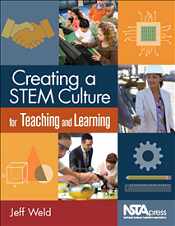Creating a STEM Culture for Teaching and Learning
By Carole Hayward
Posted on 2017-10-12
Creating a STEM Culture for Teaching and Learning by Jeff Weld offers insight for educators, policy makers, and business leaders about why STEM education matters and where it’s headed next. This new NSTA Press book includes case studies and real life vignettes from people invested in bringing meaningful STEM curricula to K-12 classrooms.
Weld, who directs the Iowa Governor’s STEM Advisory Council, was formerly an award-winning high school science teacher.
 In Creating a STEM Culture, Weld argues for a holistic approach to STEM education. “Anything short of the cultivation of a culture for STEM is insufficient. Success requires a systemic rather than a piecemeal approach to STEM education. All dimensions of schooling must be on the table—teacher preparation, scheduling, school-parent relations, professional development, curriculum, assessment, the disciplines, physical space, administrator support, business and community engagement, and of course budgets. STEM is ushering an invigorating evolution of education,” Weld states in the opening chapter.
In Creating a STEM Culture, Weld argues for a holistic approach to STEM education. “Anything short of the cultivation of a culture for STEM is insufficient. Success requires a systemic rather than a piecemeal approach to STEM education. All dimensions of schooling must be on the table—teacher preparation, scheduling, school-parent relations, professional development, curriculum, assessment, the disciplines, physical space, administrator support, business and community engagement, and of course budgets. STEM is ushering an invigorating evolution of education,” Weld states in the opening chapter.
Weld notes that in the U.S., 47 states have launched Science-Technology-Engineering-Mathematics initiatives; globally, STEM has been an educational priority in many countries. In this book, Weld makes the argument for why STEM matters both inside and outside of school walls.
For school leaders, the book offers a road map for building community support and understanding to help them bring their districts and individual schools to the forefront of the nation’s STEM initiatives. For K-12 educators, the book offers practical tips and strategies for creating a classroom culture that includes effective and well-integrated STEM education.
For policy makers, Creating a STEM Culture makes the case for integrating STEM-related policies at the local, regional, state, and national policy levels. Also, for business leaders, the book explains why it is important to collaborate with the K-12 education system to create a future workforce that is prepared for careers that might not even yet exist.
Creating a STEM Culture is meant to create conversation. In fact, the book compiles a range of opinions from different sectors addressing two central questions: what scares people about adopting STEM education, and what excites them about adopting STEM education.
“The one thing that worries me most about America’s STEM movement that we need to get right is the opportunity for all students (not just the best and brightest) to become STEM literate. By this, I am referring to their ability to not only be able to know and understand basic science and mathematical facts and concepts as they apply to the natural and known world, but to also have the capacity to observe real-world situations and apply their STEM knowledge in a way that embraces and employs the technological problem-solving and engineering design processes to effectively create viable solutions,” says Steven Barbato, executive director and CEO, International Technology and Engineering Educators Association (ITEEA).
Read the free sample chapter, “Community Buy-in for STEM”, to learn about authentic examples of public awareness strategies that have been used to promote STEM in local communities.
This book is also available as an e-book.
Follow NSTA
Disclaimer: The views expressed in this blog post are those of the author(s) and do not necessarily reflect the official position of the National Science Teaching Association (NSTA).


